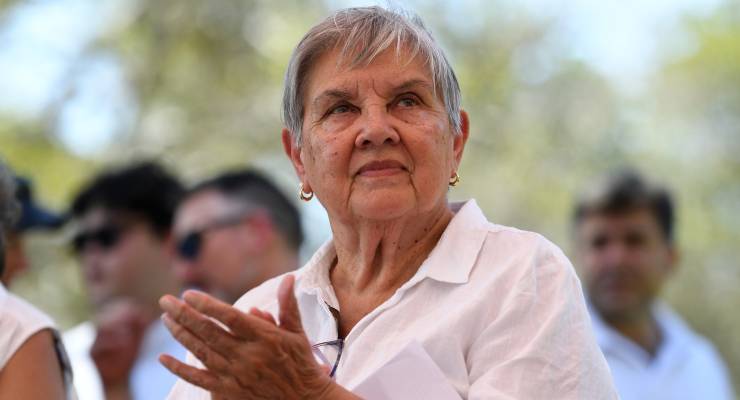
The Uluru Dialogue announced another four online yarning circles today as part of its Yes campaign for an Indigenous Voice to Parliament.
Starting Monday April 24, the next iteration of the “Start a yarn” sessions will give Indigenous and non-Indigenous Australians an opportunity to ask questions, clear up any confusion, and acquaint themselves with the ins and outs of the Voice.
“It’s to give everybody out there, just ordinary folk like us, information on how it’s all going to work and what it’s going to do,” Alyawarre woman and member of the referendum council Pat Anderson AO told one of the yarning circles.
Be it the procedural affairs of constitutional law, weighing up the order of appearance for voice-treaty-truth, explaining the referendum on paper and in practice, and debunking all manner of myths coming from Canberra and community, the yarns are designed as safe spaces to “yarn directly with the Australian people”.
The additional four sessions, over Zoom, follow on from the six Start a yarns convened by the Uluru Dialogue throughout March and April. These were attended by anyone and everyone, with just an email address required to register. The Uluru Dialogue did not collect data on who attended the sessions, but there were more than 80 people on the session Crikey attended.
These conversations were all off-the-record, but Crikey received permission from the Uluru Dialogue to publish content from the three chairs — Anderson, fellow member of the referendum council and Cobble Cobble woman Professor Megan Davis, along with Salvation Army national reconciliation action plan coordinator and Cobble Cobble woman Lucy Davis.
Why the need for a yarn?
A yarning circle is what Lucy Davis described as a universal First Nations practice, but the session Crikey attended was unique to Davis’ own Cobble Cobble people of the Barunggam nation. For her people, these circles revolved around the Bunya Mountains where every three years clans would gather.
“They would sit in a circle and each circle would have a purpose. There would be men’s circles and women’s circles. It was a place where we negotiated boundaries, it was a place where we negotiated marriages and war and conflict,” Davis told those gathered on the call.
“And this concept that I’m using here, I’ve gained permission from my old people to use it in this space.”
These yarns set the tone for the Dialogue’s campaign for a Yes vote, with talking one of the ways it hopes to circulate information. It wants people to “invite a conversation” with family, friends, colleagues, mob and community on what the referendum is and who it’s for. In short: send the information that’s “already out there” far and wide via word of mouth.
“It is very much about just starting those yarns with Aussies and getting Aussies to start those yarns with their families and friends and spreading the word,” Megan Davis said. “That’s how it happened in ’67, and that’s how we hope it happens now.”
The Dialogue also believes that the more it can get people to talk, the more chance it has of combatting counter-narratives and misinformation.
What did they yarn about?
To set the tone for a Q and A session, a short video was played explaining where the Uluru Statement from the Heart came from, how it was established, how they landed on the wording and the sequence of voice-treaty-truth, and what it means to be in the hands of the Australian people.
“It was unanimous that it would be gifted to the Australian people,” Anderson said. “Our mob knew that it’s the people of Australia who have the power to change the constitution, not the politicians.”
The questions then flowed on disagreement among Indigenous people, whether constitutional recognition had implications for sovereignty, the addition of words in the referendum (which Davis said was a “political decision, not a legal one”), whether the statement would hit a wall with Country Liberal Party Senator Jacinta Nampijinpa Price as the opposition’s Indigenous affairs spokesperson, and overwhelmingly the either-or and what-comes-first debate about voice-treaty-truth.
“We don’t look at it like a race and we don’t look at it like a rank, but it is a sequence,” Megan Davis said.
The yarn has a sequence of its own: it must not stay stagnant. The session finished with Lucy Davis telling participants they need to keep asking “deadly questions”, keep getting answers and keep sharing all of it with others.
“What we do in country and spirit is we let the yarn go,” she said. “So it’s important that when we finish, open your doors and windows and let that yarn go so mother earth can grab that yarn and she can direct it where it needs to be directed.”








The Voice needs something as simplistic & effective as the old ‘slip slop slap’ message to sell it.
The Irish are using
Ar gcroí le do croí
Our heart with your heart
They opened their hearts to us we are opening our hearts to theirs
This is not a final destination this is the start of a journey together
I think it explains what is happening
How do you discuss what the Voice will do when it all depends on what Parliament says it can do? That’s honestly what worries me about this whole thing. The Yes case says it will do this and it will do that, but at the same time says that it will all depend on what Parliament decides. I don’t see how you can have both.
Have you read the Constitution? It doesn’t say much about exactly how things will be run.
As a matter of fact I have read it, probably more often and more closely than you have. You missed my point. How can you have a discussion about what the Voice will or won’t do when it hasn’t been decided yet?
Because there’s literally been over 10 years of concept development. We may not know the exact machinery of the Voice, but the principles are there. The machinery will likely change over time, like any other institution. If you don’t support the structure that is ultimately passed by Parliament, then contact your MP to object to it . The conservatives have pretty much demonstrated they would abolish any legislated Voice the first time they have an opportunity to do so.
Yup but they can also do like ABC – stack and defund it
See about for simple additions that ensure it’s representative, funded and not muzzled by confidentiality and proceed
I’m voting yes I’d just be a lot happier if these principles were in the constitution
Above
The point is that the first version will be set up by labour according to the First Nations constitutional and legal experts who have thought the whole thing through
Then Liberals will try to destroy it
How Australia works
The Constitution doesn’t mention a prime minister or cabinet – is that of concern, too?
That’s true but there were conventions established in UK so there was an understanding of how parliament would work.
Let’s stop considering #Brextian the height of what we should do
Australian thought for Australian future
I didn’t say it was. I was just pointing out that when the Australian Constitution was written there was an understanding of how parliament would work because of established conventions. As such, it’s not a great analogy.
No Executive covers that
Maybe you should join one of the yarns and see what you think of what others have to say? Maybe they would enjoy yarning things through with you too?
I proposed changes
1 Add representative to voice
2.add yearly report of representation and outcomes
3. change process section to limited by
Voice must be representative
Must have resources to
Most be allowed to speak directly to the Australian people
Price vs Burbey
Wyatt vs Mundine
The next time someone claims to speak for First Nations
I should know that they were selected by First Nations
That is the voice
We can’t just pick a First Nations person and say that they speak for a continent